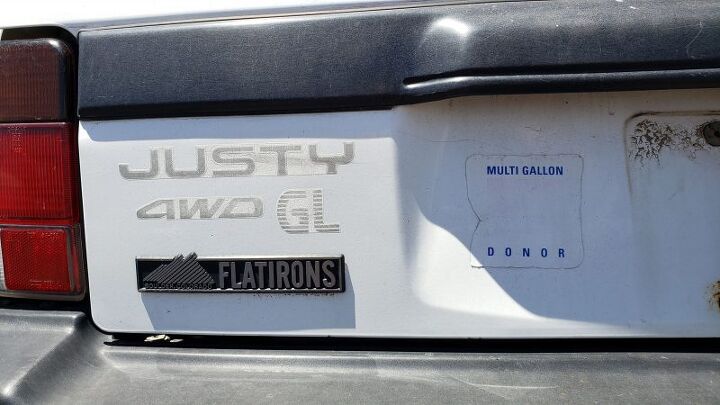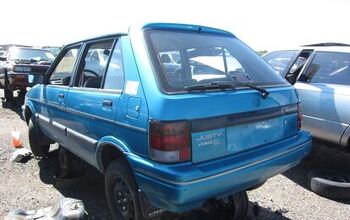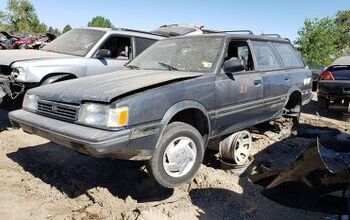Junkyard Find: 1990 Subaru Justy 4WD GL

The General began selling the Suzuki Cultus hatchback with Chevrolet Sprint badges here starting in the 1985 model year, with the later versions becoming the Geo/ Chevrolet Metro. Even though gasoline prices had crashed during the middle 1980s, the three-cylinder Sprint sold well enough that Subaru decided to bring their tiny three-cylinder car to our shores. This was the Justy, and I’ve found this ’90 in a self-service yard in Subaru-crazed Denver.
You could buy the Justy here for the 1987 through 1994 model years, with the four-wheel-drive version appearing in the 1988 model year. At $8,156 (about $18,405 in 2022 dollars), it was the cheapest four-wheel-drive car you could buy in North America that year (yes, the $7,999 Suzuki Samurai was a bit cheaper, but it wasn’t a car).
This being Colorado, I find plenty of 4WD Justys in the car graveyards here; the front-wheel-drive examples have been much harder to find.
While the Metro eventually got a four-cylinder engine, every Justy sold new on our continent was a three-banger. This engine displaced 1,189 cubes (centimeters, that is) and had 73 fuel-injected horsepower (the entry-level Justy DL had a carburetor and 66 horses).
There was a version with a continuously variable transmission available in 1990, but this car has the five-speed manual. Check out that big 4WD button on the shifter, a feature you saw in a lot of Subarus of that era.
Though Subaru had just begun selling cars here with true all-wheel-drive systems by 1990 (and went to all-wheel-drive in all their North American offerings for 1996), most 1990 Subarus that could send power to all four corners did so via a system that required the driver to select between front- and four-wheel-drive manually. If you drove for long periods on dry pavement with the car in the 4WD setting, you’d tear up the tires and maybe the drivetrain. I find it interesting that the 4 in this badge could be read as an A; the “all-wheel-drive” term hadn’t come into widespread use at the time, but Subaru saw it coming and— presumably— didn’t want to be forced to design new decals.
How many miles did it have when its career on the road ended? Thanks to this five-digit odometer, we can’t know.
The Justy was available in North America as a hatchback with three or five doors. In Taiwan, car shoppers could get a notchback version called the Tutto.
The interior in this one still looks pretty good, despite the rough handling given to car upholstery by the High Plains sun.
There’s rust where you’d expect it, though, and that’s a death sentence for a tiny hatchback with too many pedals.
Air conditioning? Factory cassette deck? Not in this car!
It took Subaru a few more years to completely ditch the idea of selling bargain-basement miserable econoboxes here.
For links to more than 2,200 additional Junkyard Finds, check out the Junkyard Home of the Murilee Martin Lifestyle Brand™.
[Images by the author]

Murilee Martin is the pen name of Phil Greden, a writer who has lived in Minnesota, California, Georgia and (now) Colorado. He has toiled at copywriting, technical writing, junkmail writing, fiction writing and now automotive writing. He has owned many terrible vehicles and some good ones. He spends a great deal of time in self-service junkyards. These days, he writes for publications including Autoweek, Autoblog, Hagerty, The Truth About Cars and Capital One.
More by Murilee Martin
Latest Car Reviews
Read moreLatest Product Reviews
Read moreRecent Comments
- CM Korecko Cadillacs traditionally have been opulent, brash and leaders in the field; the "Standard of the World".That said, here's how to fix the brand:[list=1][*]Forget German luxury cars ever existed.[/*][*]Get rid of the astromech droid names and bring back Seville, Deville, Eldorado, Fleetwood and Brougham.[/*][*]End the electric crap altogether and make huge, gas guzzling land yachts for the significant portion of the population that would fight for a chance to buy one.[/*][*]Stop making sports cars and make true luxury cars for those of us who don't give a damn about the environment and are willing to swim upstream to get what we really want.[/*][*]Stop messing around with technology and make well-made and luxurious interiors.[/*][*]Watch sales skyrocket as a truly different product distinguishes itself to the delight of the target market.[/*][/list=1]
- FreedMike Not surprisingly, I have some ideas. What Cadillac needs, I think, is a statement. They don’t really have an identity. They’re trying a statement car with the Celestiq, and while that’s the right idea, it has the wrong styling and a really wrong price tag. So, here’s a first step: instead of a sedan, do a huge, fast, capable and ridiculously smooth and quiet electric touring coupe. If you want an example of what I’m thinking of, check out the magnificent Rolls-Royce Spectre. But this Cadillac coupe would be uniquely American, it’d be named “Eldorado,” and it’d be a lot cheaper than the $450,000 Spectre – call it a buck twenty-five, with a range of bespoke options for prospective buyers that would make each one somewhat unique. Make it 220 inches long, on the same platform as the Celestiq, give it retro ‘60s styling (or you could do a ‘50s or ‘70s throwback, I suppose), and at least 700 horsepower, standard. Why electric? It’s the ultimate throwback to ‘60s powertrains: effortlessly fast, smooth, and quiet, but with a ton more horsepower. It’s the perfect drivetrain for a dignified touring coupe. In fact, I’d skip any mention of environmental responsibility in this car’s marketing – sell it on how it drives, period. How many would they sell? Not many. But the point of the exercise is to do something that will turn heads and show people what this brand can do. Second step: give the lineup a mix of electric and gas models, and make Cadillac gas engines bespoke to the brand. If they need to use generic GM engine designs, fine – take those engines and massage them thoroughly into something special to Cadillac, with specific tuning and output. No Cadillac should leave the factory with an engine straight out of a Malibu or a four-banger Silverado. Third step: a complete line-wide interior redo. Stop the cheapness that’s all over the current sedans and crossovers. Just stop it. Use the Lyriq as a blueprint – it’s a big improvement over the current crop and a good first step. I’d also say Cadillac has a good blend of screen-controlled and switch-controlled user interfaces; don’t give into the haptic-touch and wall-to-wall screen thing. (On the subject of Caddy interiors – as much as I bag on the Celestiq, check out the interior on that thing. Wow.)Fourth step: Blackwing All The Things – some gas, others electric. And keep the electric/gas mix so buyers have a choice.Fifth step: be patient. That’s not easy, but if they’re doing a brand reset, it’ll take time.
- NJRide So if GM was serious about selling this why no updates for so long? Or make something truly unique instead of something that looked like a downmarket Altima?
- Kmars2009 I rented one last fall while visiting Ohio. Not a bad car...but not a great car either. I think it needs a new version. But CUVs are King... unfortunately!
- Ajla Remember when Cadillac introduced an entirely new V8 and proceeded to install it in only 800 cars before cancelling everything?













































Comments
Join the conversation
I remember reading a review of a justy with a CVT by one of the automotive rags back in the day. IIRC it had a side bar on how a CVT works. That coupled with the review, that criticized mostly the CVT and not so much the Justy, made my decision to never buy a vehicle with a CVT.
"There was a version with a continuously variable transmission available in 1990" Really?